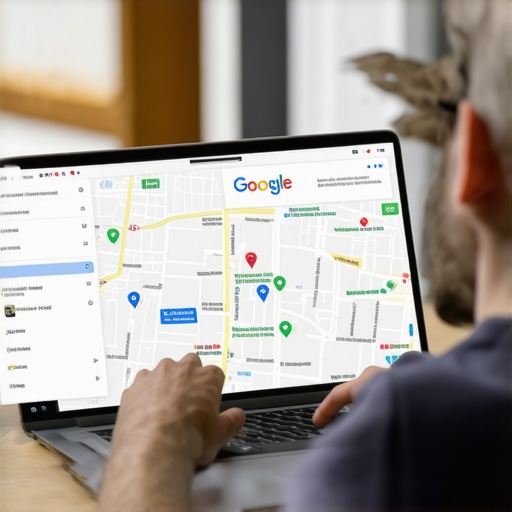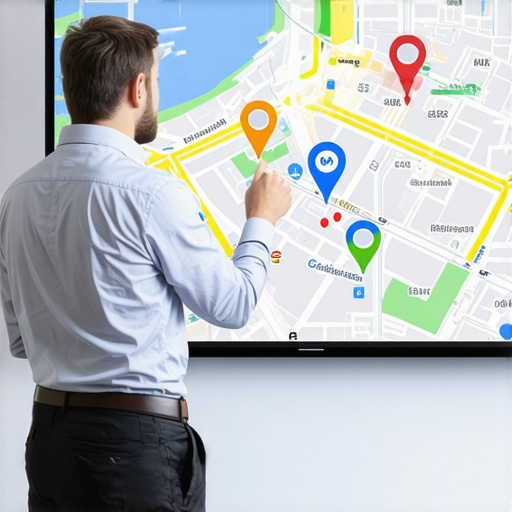My First Encounter with Google Maps Optimization
I’ll never forget the day I realized how crucial Google My Business (GMB) was for local success. As a small business owner, I knew that appearing prominently on Google Maps could make or break my customer flow. I decided to dive deep into GMB optimization secrets, eager to elevate my local presence.
How I Transformed My Profile for Better Visibility
Initially, my GMB profile was a basic listing with minimal info. I learned that optimizing my profile meant more than just filling out details; it required strategic enhancements. I added high-quality photos, consistent NAP information, and used relevant keywords naturally. These efforts, inspired by expert advice, helped my business climb the local search rankings significantly.
Why Higher Google Maps Rankings Matter in 2025
In 2025, local SEO continues to evolve rapidly. According to Google Maps 3-Pack mastery guides, ranking higher on Maps not only increases visibility but also drives more traffic and conversions. I noticed that appearing in the 3-Pack boosted my credibility and brought in a steady stream of new customers.
What Are the Key Strategies to Rank Higher on Google Maps?
From my experience, a combination of consistent positive reviews, local link building, and accurate business categories are essential. I also used proven promotion techniques to accelerate my rankings. Engaging with customers through reviews and Q&A sections further cemented my local authority.
How Can I Maintain and Improve My Rankings Over Time?
Maintaining rankings requires ongoing effort. Regularly updating your profile, responding promptly to reviews, and sharing fresh content are vital. I also keep an eye on competitor strategies by reviewing their profiles, which helps me stay ahead in the local search game. For detailed insights, I recommend exploring ultimate guides to ranking your GMB.
If you’re serious about dominating local searches, I encourage you to experiment and keep learning. Share your experiences below, or visit this contact page if you need personalized tips. Remember, in 2025, strategic GMB profile optimization is your ticket to local success!
The Role of Local Citations in Elevating Your Google Maps Visibility
One often overlooked yet powerful tactic in local SEO is building high-quality local citations. Citations—mentions of your business name, address, and phone number—serve as trust signals for Google, reinforcing your business’s legitimacy and relevance. Ensuring consistency across directories like Yelp, Bing Places, and industry-specific sites is crucial. When your NAP information aligns perfectly everywhere, it minimizes confusion and boosts your chances of ranking higher in local search results.
How to Leverage Customer Engagement for Long-Term Success
Engagement doesn’t stop at collecting reviews. Active management of your reviews, responding thoughtfully to both positive and negative feedback, enhances your business’s reputation and signals to Google that you prioritize customer satisfaction. Incorporate strategies like asking satisfied customers for reviews and utilizing the Q&A section to address common questions. Additionally, sharing updates, promotions, or new services through Google Posts keeps your profile fresh and engaging. For a comprehensive approach, explore ultimate guides to ranking your GMB.
What Are the Hidden Factors That Could Be Sabotaging Your Local SEO Efforts?
While optimizing your profile is essential, several hidden pitfalls can undermine your progress. For instance, inconsistent business information, neglecting to optimize your categories, or failing to utilize relevant keywords in your descriptions can hinder your ranking potential. Moreover, neglecting mobile optimization and user experience can deter visitors, increasing bounce rates and reducing your visibility. Regular audits of your profile and competitor analysis can reveal these hidden issues. For expert insights, check out top Google Maps SEO services.
If you’re eager to accelerate your local rankings, sharing your experiences or questions in the comments can spark insightful discussions. For personalized guidance, consider reaching out via our contact page. Remember, mastering Google Maps in 2025 requires a nuanced, strategic approach that stays ahead of algorithm changes and consumer behaviors.
Unveiling the Nuances of Local SEO: My Personal Reflection
Over the years, my experience with Google Maps optimization has evolved from basic listing tweaks to an intricate dance of strategic planning and nuanced execution. I recall the early days when simply updating my business hours and adding a few photos seemed sufficient. However, as local SEO algorithms became more sophisticated, I realized that true mastery required understanding the deeper layers of Google’s ranking signals. This journey has been both challenging and rewarding, pushing me to continuously learn and adapt.
What Are the Hidden Factors That Drive Long-Term Success?
One aspect I’ve come to appreciate is the importance of long-term strategic planning. Building a resilient profile isn’t just about quick wins; it’s about cultivating a consistent brand presence across multiple platforms. For example, maintaining high-quality local citations and ensuring NAP consistency across directories like Yelp, Bing Places, and industry-specific sites creates a cohesive signal that Google trusts. In my experience, neglecting these details can be a silent killer of rankings, as even minor inconsistencies can undermine credibility and search performance.
How Do I Tackle the Challenge of Algorithm Changes?
Google’s algorithms are notoriously unpredictable, but I’ve learned that staying ahead involves proactive monitoring and flexibility. Regularly auditing my GMB profile and competitor profiles reveals shifts in ranking factors—sometimes subtle, sometimes dramatic. I often leverage tools and insights from authoritative sources like Google Maps 3-Pack mastery guides to anticipate and adapt to these changes. It’s also vital to keep experimenting with new tactics—like leveraging Google Posts more creatively or integrating localized content strategies. My personal approach is to treat each update as a learning opportunity, refining my methods accordingly.

Another layer of complexity is understanding the local consumer behavior and how it influences ranking signals. For example, recent studies suggest that mobile search intent and user engagement metrics play an increasingly significant role in local rankings. I’ve started focusing more on optimizing my profile for mobile, ensuring fast load times, and crafting compelling calls to action that encourage reviews and interactions. Recognizing these subtle cues has made a noticeable difference in my visibility and customer engagement.
What Are the Ethical Considerations in Local SEO?
As I delve deeper into local SEO tactics, I’ve become increasingly aware of the importance of ethical practices. It’s tempting to resort to shortcuts like fake reviews or manipulative link schemes, but I’ve found that genuine engagement and authentic optimization yield sustainable results. Google’s algorithms are becoming more adept at detecting inauthentic signals, and I prefer to build my reputation through honest interactions. Sharing my experiences and inviting honest feedback not only builds trust but also aligns with the long-term health of my business.
Inviting Your Personal Experiences and Insights
Every local business has unique challenges and opportunities. I encourage you to share your own stories, successes, and lessons learned in the comments below. What strategies have worked best for you? How do you stay adaptable amidst Google’s evolving landscape? If you’re eager to dive deeper into advanced tactics, explore additional resources like expert GMB tips or consider consulting with local SEO professionals to tailor strategies to your niche.
Deciphering the Complexities of Local Search Algorithms
Beyond the foundational tactics, understanding the intricate signals influencing Google Maps rankings is crucial. Recent studies, such as those highlighted by Moz, emphasize the significance of user engagement metrics, including click-through rates (CTR), dwell time, and bounce rates, in shaping local search outcomes. As I delved deeper, I realized that optimizing for these behavioral signals requires a holistic approach that integrates website performance, user experience, and compelling Google Posts.
Implementing Hyper-Localized Content Strategies
One game-changing approach I adopted involved creating hyper-localized content tailored to specific neighborhoods, landmarks, or community events. This strategy not only boosts relevance but also aligns with the evolving Google emphasis on contextual relevance. For instance, integrating local news, community stories, and event updates into my profile and website helped establish authority and fostered stronger local relationships. Such nuanced content elevates your profile’s relevance, making it more appealing to both users and search algorithms.
How Can Advanced Schema Markup Elevate Your GMB Profile?
Implementing schema markup, particularly LocalBusiness schema, enhances your profile’s visibility with rich snippets, improved CTR, and better context comprehension by Google. According to Search Engine Journal, structured data can significantly influence how your business appears in local packs and organic results. I invested time in deploying comprehensive schema, including service-specific and event schemas, which contributed to a more authoritative and trustworthy online presence. This meticulous attention to detail often differentiates top-ranking profiles from the competition.
What Role Do Offline Strategies Play in Digital Local SEO Dominance?
While digital tactics are vital, integrating offline marketing efforts—such as sponsoring local events, participating in community initiatives, and leveraging local print media—amplifies your local footprint. These activities generate authentic citations and backlinks, reinforcing your business’s presence and credibility in the community. My experience shows that a balanced blend of online and offline strategies creates a resilient ecosystem that Google recognizes and rewards, especially in competitive markets.
How Do I Sustain and Scale My Local SEO Efforts Over Time?
Sustaining long-term success requires systematic monitoring and iterative improvements. I utilize advanced analytics tools like BrightLocal and Whitespark to track citation consistency, review sentiment, and ranking fluctuations. Regularly auditing these metrics and adjusting strategies accordingly helps prevent ranking erosion. Additionally, fostering genuine community engagement—such as hosting local workshops or charity events—builds lasting goodwill and organic backlinks, further strengthening my local authority. For comprehensive guidance, I suggest exploring the ultimate blueprint for 2025.
If you’re serious about elevating your local SEO game, I invite you to share your insights or challenges below. For personalized support, don’t hesitate to reach out via this contact page. Remember, mastering these advanced strategies is essential to outsmart the evolving Google landscape and secure sustained local dominance.
Things I Wish I Knew Earlier (or You Might Find Surprising)
Hidden Depths of Local SEO
Looking back, I realize that focusing solely on basic profile updates was a mistake. The real game-changer was understanding how Google’s algorithm values local relevance and engagement metrics. My early efforts lacked strategy, and I saw slow growth until I started incorporating hyper-local content and schema markup, which made a notable difference.
The Power of Consistency
One surprising lesson was how crucial NAP consistency across directories truly is. I once neglected to update my info everywhere, and it cost me rankings. Once I corrected this, my visibility improved dramatically. It’s a simple detail but has outsized importance.
Offline and Online Synergy
Integrating offline community efforts, like sponsoring local events, with my online profile boosted my credibility and citation count. This holistic approach created a trust signal Google couldn’t ignore, leading to higher rankings.
Staying Ahead of the Curve
Google’s updates are relentless. I learned to monitor rankings regularly and adapt quickly. Tools like BrightLocal and insights from authoritative sources helped me stay competitive, especially by leveraging new features like Google Posts more creatively.
Authentic Engagement Matters Most
Fake reviews or manipulative tactics might seem tempting but proved counterproductive. Genuine reviews and honest responses built my reputation and sustained long-term growth, proving that authenticity really does pay off.
Resources I’ve Come to Trust Over Time
- Google Maps 3-Pack Mastery: This guide helped me understand the intricate ranking factors and stay ahead of algorithm changes. It’s a must-read for serious local SEO practitioners.
- Moz’s Local SEO Resources: Moz’s articles and tools provided me with a solid foundation and advanced insights into local ranking signals. Highly recommended for ongoing learning.
- BrightLocal Blog: Their real-world case studies and updates kept me informed about the latest trends and effective strategies, making it easier to refine my approach.
- Google’s Official Guidelines: Always refer back to Google’s own documentation. It’s the most reliable source for understanding what’s expected and what to avoid.
Parting Thoughts from My Perspective
Reflecting on my journey with Google Maps optimization in 2025, I realize that success is a mix of technical precision, authentic engagement, and staying adaptable to ongoing changes. The most valuable takeaway is that strategic consistency combined with genuine community involvement will always set you apart from competitors. If this resonated with you, I’d love to hear your thoughts. Feel free to share your experiences or ask questions — together, we can navigate the complex world of local SEO and achieve lasting success.


Reading about the evolution of Google My Business optimization really resonates with my own journey. I started out focusing mainly on keyword stuffing and keyword-rich descriptions, thinking that would boost my rankings. However, over time, I discovered that consistent NAP details and genuine customer engagement have a far greater impact on local search visibility. I’ve seen firsthand how ASKING for reviews from satisfied clients and responding to every single one—positive or negative—strengthens trust and boosts rankings naturally. One challenge I still face is balancing local content creation with other marketing efforts—how do others find the time to keep their profiles fresh and relevant consistently? I’d love to hear what tools or strategies you use to stay on top of your local SEO activities without feeling overwhelmed.